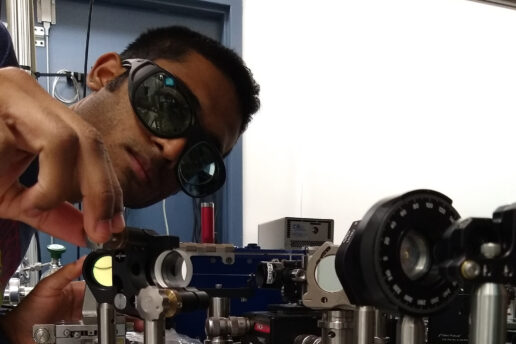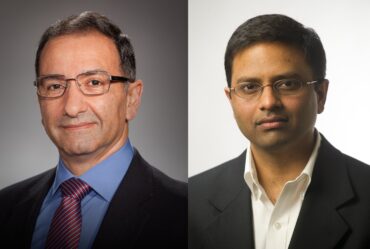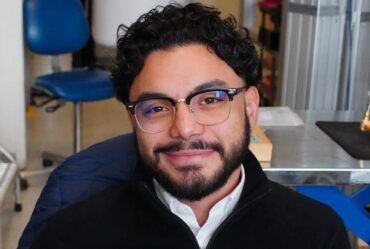
Working at Light’s Quantum Frontier
Sahil Pontula ’23 sees endless possibilities for the future through quantum optics
Light has something of a split personality, sometimes acting like a form of electromagnetic radiation, traveling in waves, other times like a stream of particles, which are called photons.
That dual nature was explained in the early 20th century by quantum theory, which shows how it’s possible for something to be two different things at different times.
It’s not something we notice. In the macroscopic world of our senses (or, as physicists call it, the “classical” world), light is light, even if it comes in different colors. In the strange realm of quantum physics, however, the dual particle-wave nature of light means that light can exist in exotic varieties and in states that are not only fascinating in themselves but that can open pathways to new and powerful technologies. This is the world that PhD student Sahil Pontula ’23 is exploring.
The path to MIT
Pontula was always keenly interested in science, particularly astrophysics and astronomy. “What brought me to MIT is that I knew I wanted to do physics for sure, but I also knew MIT is a great engineering school. MIT was the perfect choice.”
Seeking a hands-on approach to science, he double majored in physics and electrical engineering. “I realized that I really wanted to be able to go into the lab and play with optics, play with materials, and be able to observe new physics. With astrophysics, the systems you’re dealing with are potentially millions of light-years away. It’s not the same as being able to go into the lab and see these really cool quantum optics experiments.”
After graduating in three years, Pontula began a doctoral program in the fall of 2023 in electrical engineering and computer science, continuing his work in the lab of Marin Soljačić ’96, professor of physics. Pontula’s achievements were recognized with one of 15 fellowships awarded in 2023 by the Fannie and John Hertz Foundation, a distinction that will provide him with five years of doctoral-level funding as well as mentorship from a network of more than 1,200 former Hertz Fellows, many of whom are accomplished scholars and leaders. “I’m continually inspired by other Hertz Fellows,” says Pontula, “who are researchers at heart but aren’t afraid to take their science out of the lab and into real-world applications.”
A quest for “exotic” states of light
Pontula’s research centers around nonlinear and quantum optics, which involves the interactions of light and matter at the quantum level. “For decades now,” he explains, “people have been trying to generate states that are not classical. The closest thing we get to quantum in the classical world is lasers, which are what we call coherent states of light.” Unlike normal light, which scatters haphazardly in every direction, in a laser, the light waves move in orderly lockstep, like lines of soldiers all marching to the same tune. That quality, called coherence, allows the laser light to be used for all sorts of tasks such as carrying vast amounts of data, performing eye surgery, or playing with cats.
In quantum optics, however, that’s only the beginning. “In quantum mechanics, it turns out you can generate more exotic states,” Pontula says. “This has a bunch of really cool applications.”
New ideas taking on old problems
There are large obstacles to achieving quantum states of light: not only are they very difficult to create, but once created, they’re extremely delicate, falling apart at the slightest hint of noise or vibration. That makes scaling them up for use in actual applications quite a challenge. “For example, if you try to make a state with, say a hundred photons, that’s much more difficult than making a state with single photons,” explains Pontula. “And as it is, generating a state with single photons isn’t exactly trivial. Now we have fairly reliable ways to do it, but trying to get a state with a hundred photons is much more difficult because any time you try to introduce any kind of loss, your state gets destroyed.”
That’s the focus of much of Pontula’s laboratory work. “I use existing platforms like lasers and optical parametric oscillators to try to engineer these in special ways, using tools from nonlinear optics and quantum optics, to generate these states of light that are resilient to noise,” he explains. “A lot of my work is at the intersection of theory and experiment.”
Real-world applications for the future: communications, medicine, energy storage
As fascinating as it may be working at the cutting edge of quantum optics theory, Pontula is also keen to find ways to extend his laboratory work to practical applications. “I’m very interested in the fundamental physics side, but I also want to make sure that this goes outside the lab and is actually translated into real-world devices.”
What kind of applications might quantum light states make possible? “Communications is one I’m pretty excited about,” says Pontula. Other possibilities include quantum computing and various types of sensing devices, which would use the “squeezed states” of quantum light to operate.
“I’m very interested in the fundamental physics side, but I also want to make sure that this goes outside the lab and is actually translated into real-world devices.”
Sahil Pontula ’23
“Another big application I’m looking at is sources of coherent light at difficult-to-achieve wavelengths,” he continues, pointing out that while it’s easy to find lasers using optical or infrared wavelengths, other wavelengths such as X-rays are much more difficult to achieve with lasers. “One of the ways we have to generate coherent states at these wavelengths is using free electron lasers, which right now are very big and expensive,” he explains. “They take up an entire building. So one of the projects I’m hoping to start soon is trying to use nanophotonics to be able to shrink the form factor of these devices, potentially even eventually being able to put them on chips. This would have a revolutionary impact.”
Such devices could be especially important for medical imaging, he says, perhaps generating coherent states in X-rays. “Medical imaging is very inefficient. It has a huge energy footprint. If you had a laser source that could efficiently generate these wavelengths from infrared to X-ray, the applications are really exciting.”
Pontula also hopes to apply quantum optics to energy storage. Unlike quantum computers, which store data using a quantum phenomenon called spin, a quantum battery would use the same principle to store energy. Such a device could charge in seconds rather than hours. “The big challenge right now is being able to store that energy,” Pontula says. “You can charge it very fast, which is great, but now, the spins decay very quickly, so you release that energy almost as fast. It remains to be seen if that can make a big enough impact to actually make it to industry.”
A future guided by light from the past
While astronomers and astrophysicists study the light generated hundreds, thousands, or millions of years ago by stars and galaxies, Pontula has found his niche creating, studying, and finding ways to use the most exotic forms of light in existence, with an eye to solving real-world problems. “It combines my love for fundamental physics but also reaches all these different applications that I’m interested in,” he says.
- Read also: Sahil Pontula ’23 wins 2023 Hertz Foundation Fellowship [MIT News, 6.21.23]


